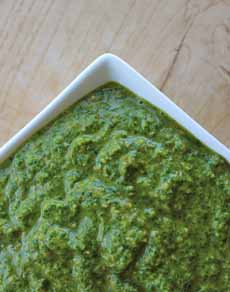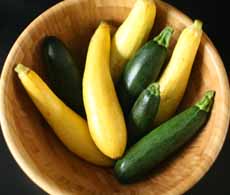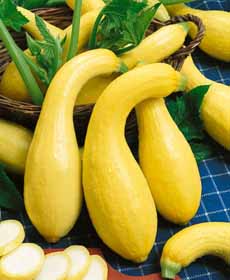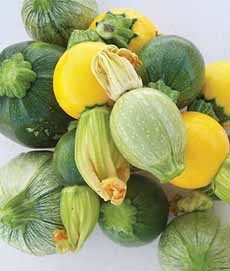TIP OF THE DAY: Chermoula Sauce With Chicken And Zucchini, Plates Or Wraps
|
While it’s easy to find something fresh and delicious in the summer months, today’s tip is a good template for year-round dinners. Simply combining broiled or grilled protein (chicken, fish) and seasonal vegetables with a tasty sauce makes a healthful, flavorful dinner any time of year. Just make (or buy) the yogurt sauce and chermoula sauce in advance (see “What Is Chermoula, below). You can also use tzatziki—a cucumber-garlic-yogurt dip often found ready-made in with the other refrigerated dips—or its Indian relative, raita. Click on the links for recipes. We adapted this recipe from a Good Eggs meal kit. You plate the food individually, or pass a platter with flatbread (naan, pita, tortillas) to pass around. > Summer squash: The difference between green squash and yellow squash. Chermoula is a North African marinade and sauce popular in the cuisines of Algeria, Libya, Morocco, and Tunisia. As with pesto recipes, there are countless regional variations both in ingredients and proportions. But chermoula usually starts with a mixture of fresh herbs (especially cilantro), olive oil, lemon juice, cumin, garlic, and salt. Flavorful chermoula is typically used with fish and seafood, and its green color adds brightness to what we personally refer to as “the ubiquitous beige and brown foods.” Variations include black pepper, fresh coriander, ground chiles, onion, pickled lemons, and saffron, among others. Chermoula is also used to flavor meat, poultry, and vegetable dishes. You can use it to coat fish and chicken before broiling; we love it as a condiment with lamb. Here’s the recipe for chermoula sauce. While we crave the smoky, summery flavor of food off the grill, we don’t have access to one in our small city apartment. Our broiler is our substitute. As a time saver (and to avoid cleaning the broiler), we often buy pre-broiled chicken breasts at Trader Joe’s. You can make the chermoula and yogurt sauces up to 3 days in advance. You can use the chermoula or yogurt sauces on the salad in addition to the wraps, or pick another salad dressing of your choice. Ingredients 1. MARINATE the chicken at least 30 minutes before cooking, to 2 hours or overnight. Mix all ingredients of the marinade in plastic zip-lock bag. Add the chicken and make sure that every piece is covered evenly. Marinate in a fridge for at least 30 minutes to 2 hours or, better yet, overnight. Place the chicken and all of the marinade in a baking dish. 2. PREHEAT the broiler and line a sheet pan with aluminum foil. Wrap the flatbread in aluminum foil. Bring the sauces from the fridge and place in serving bowls to warm, and set aside. 3. RINSE and slice the squash and spring onions at an angle, into coins. Toss with a pinch of salt and some olive oil and arrange in a single layer over half of the sheet pan. Place the chicken on the other half, leaving space in between each piece. Drizzle the marinade over the chicken if desired, but don’t reuse any protein marinade (uncooked marinade can retain bacteria from the raw proteins). 4. BROIL on the top rack of the oven for 8 minutes, or until the chicken is cooked through and the vegetables have browned. Then, place foil-wrapped bread on the bottom rack of the oven to heat for 2 minutes, or until warmed through. While the chicken is broiling… 5. WASH the romaine and prepare any other salad ingredients of your choice. 6. REMOVE both the sheet pan and bread from the oven. Plate and serve chicken and veggies with a dollop of yogurt sauce, a drizzle of chermoula, and warm lavash! ________________ *Thinner is better: Thinner squash are more tender than fatter ones, and better suited for rolling in the flatbread. †Spring onions substitute: Spring onions are not the same as green onions/scallions. They are immature bulbs of red or yellow onions, with bulbs about 1-inch in diameter and green tops that can either be eaten fresh or cooked. If you can’t find them, pick the smallest yellow onions from the bin. ‡Easy marinade: Some Americans have defaulted to marinating chicken in bottled Italian salad dressing, which may be convenient but is pricier and less elegant in flavor than an easy homemade marinade. Just combine oil, acid (vinegar or citrus juice), minced garlic, salt, and pepper, plus a bit of honey or maple syrup for a nuanced sweetness. As a guide, start with 6 tablespoons olive oil, 4 tablespoons low sodium soy sauce, 2 tablespoons lemon or lime juice or wine vinegar, and flavorings of choice: 1 tablespoon Worcestershire sauce, 2 tablespoons honey, 3 to 6 cloves of minced garlic, and to taste, a few dashes of hot sauce, salt, and pepper. |
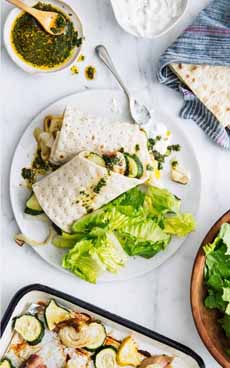 [1] Chicken-zucchini with wraps; or serve them plain (photo courtesy Good Eggs).
[6] Eight-ball squash, the size of softballs, are an heirloom variety (some are hybrids), can be found at some markets—or grow your own with seeds from Burpee. |
|
|
YELLOW SUMMER SQUASH & ZUCCHINI: THE DIFFERENCE In terms of cooking and eating, there is no difference; although some find that yellow summer squash (straight neck or crook neck) to be a bit sweeter. Both belong to the genus and species Cucurbita pepo, which originated in Mexico. Their species siblings include winter squash such as the field pumpkin and acorn squash, among others. All are subspecies of the pepo species. How can these latter thick-skinned winter squashes be siblings of the delicate-skinned summer squash? Summer squash is picked while still immature and thin-skinned so that the skin and seeds are still soft and edible. They also grow on bush-type plants that do not spread across the ground, like winter squash and pumpkin. A few healthy and well-maintained plants produce abundant yields. CHECK OUT WHAT’S HAPPENING ON OUR HOME PAGE, THENIBBLE.COM. |
||
